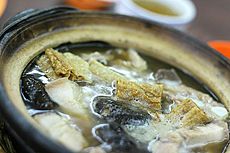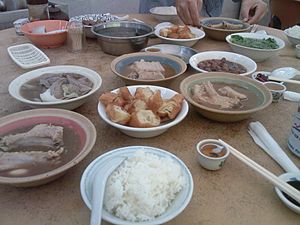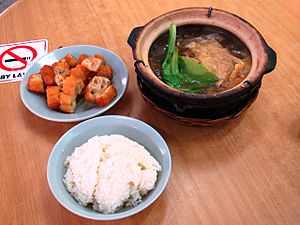Bak kut teh facts for kids

A closeup of bak kut teh
|
|
| Place of origin | Fujian, China
Klang, Malaysia Singapore (Teochew version) |
|---|---|
| Region or state | Hokkien- and Teochew-speaking areas of Malaysia, Singapore |
| Associated national cuisine | Malaysia, Singapore |
| Main ingredients | pork ribs, complex broth of herbs and spices (including star anise, cinnamon, cloves, dang gui, fennel seeds and garlic) |
| Variations | Hokkien and Teochew |
| Bak kut teh | |||||||||||||||
|---|---|---|---|---|---|---|---|---|---|---|---|---|---|---|---|
| Chinese | 肉骨茶 | ||||||||||||||
| Hokkien POJ | Bah-kut-tê | ||||||||||||||
| Literal meaning | meat bone tea | ||||||||||||||
|
|||||||||||||||
Bak kut teh (also called bah kut teh or BKT) is a delicious soup with pork ribs. It is very popular in Malaysia and Singapore. Many people from the Hoklo and Teochew communities enjoy it there.
The name Bak kut teh means "meat bone tea" in the Hokkien language. The soup is made by cooking pork ribs for hours. It uses a special broth with herbs and spices. These include star anise, cinnamon, cloves, dong quai, fennel seeds, and garlic.
Even though it's called "tea," there is no actual tea in the dish! The name refers to a strong oolong Chinese tea that is often served with the soup. People believe this tea helps to cut through the richness of the pork.
Sometimes, other ingredients are added to the soup. These can be different kinds of mushrooms, choy sum, or dried tofu pieces. Some Chinese herbs like yu zhu (Solomon's seal) and ju zhi (buckthorn fruit) can also be used. These herbs make the soup taste sweeter and stronger.
Chefs also add dark and light soy sauce while cooking. The amount of soy sauce changes depending on the type of bak kut teh. For example, the Teochew version is lighter than the Hokkien one. The dish can be topped with chopped coriander or green onions and crispy fried shallots.
Contents
How People Enjoy Bak Kut Teh
In Malaysia, bak kut teh is often served with fried dough strips called you char kway. You can dip these into the soup. People also like to add soy sauce (usually dark soy sauce) with chopped chili and minced garlic. Tea, like the Tieguanyin variety, is often served too. This is because people believe it helps balance the rich pork flavor.
In Singapore, the Teochew version of the dish is also served with youtiao. These are cut into small pieces for dipping. You can also order braised pig trotters as a side dish. Dark soy sauce with chili is a popular condiment. Some restaurants even serve tea with a special kung fu tea ceremony.
Bak kut teh is usually eaten for breakfast or lunch. The Hokkien and Teochew people have a long history of drinking tea. This tradition is a big part of their food culture.
The Story of Bak Kut Teh
Bak kut teh is a very popular dish in both Malaysia and Singapore. No one is completely sure where it first came from. Many believe it was brought from Fujian, China. It might have come from a Fujianese dish called niu pai.
In Malaysia, many people think bak kut teh started in Klang. There are different stories about how it was invented. One story says a local Chinese doctor (called a sinseh) created it in the 1930s. Another story says he brought the recipe from his hometown in Fujian in the 1940s.
Some also say the dish was made for port workers in Port Klang in the early 1900s. These workers, called coolies, needed a healthy and filling meal. Bak kut teh helped them stay strong. It became very popular among early Chinese immigrants, many of whom were from Fujian.
The Teochew version of bak kut teh was created in Singapore. It was sold near the Singapore River after World War II. By the 1960s, bak kut teh was a popular street food in Singapore. Some businesses that started with humble pushcarts grew into big restaurant chains.
The Chinese word bak (肉) means "meat" or "pork." This word is pronounced in the Hokkien way. In Teochew, it's pronounced nek. This suggests that the dish might have first come from Hokkien speakers.
Malaysia and Singapore have even had a friendly disagreement about where bak kut teh truly began. In 2009, Malaysia's tourism minister said that bak kut teh is a Malaysian dish. She felt that other countries had "borrowed" many of Malaysia's original foods.
Different Kinds of Bak Kut Teh
There are many different ways to make bak kut teh. The cooking style often depends on where the Chinese community lives.
There are three main types of bak kut teh:
- The Teochew style: This soup is light in color. It uses more pepper and garlic.
- The Hoklo (Hokkien) style: This version uses many different herbs and soy sauce. This makes the soup darker, more fragrant, and richer.
- The Cantonese style: Cantonese people love soup. They add medicinal herbs to make a stronger-flavored soup.
The easiest way to tell the Hokkien and Teochew versions apart is by their color. The Hokkien version uses more dark soy sauce, so its soup is much darker.
Dry Bak Kut Teh
A "dry" version of bak kut teh has become popular in Malaysia, especially in Klang. Even though it's called "dry," it still has a thick gravy. This gravy is made by reducing the broth. Ingredients like wolfberries, dried dates, dried chilies, and dried squid are added. The dry version tastes tangier and sharper than the soup. It is more like a herbal stew.
Other Variations
In Malaysia, there is a less fatty version of bak kut teh made with chicken instead of pork. It's called chik kut teh. This version is also halal, which means Muslims can eat it. Their religion does not allow them to eat pork.
Bak kut teh is also popular among the Chinese Indonesian community in the Riau Islands, Indonesia.
You can even find vegetarian bak kut teh in Malaysia. Instead of pork or chicken, it uses oyster mushrooms.
Malaysian National Record
On November 22, 2008, something amazing happened in Klang, Malaysia. The Klang Chinese Chamber of Commerce and Industry (KCCCI) worked with five bak kut teh sellers. They cooked the world's biggest bowl of Hokkien bak kut teh!
The giant bowl was 182.88 centimeters (about 6 feet) wide and 91.44 centimeters (about 3 feet) tall. It held 500 kilograms (about 1,100 pounds) of pork, 450 kilograms (about 990 pounds) of soup, and 50 kilograms (about 110 pounds) of herbal medicine. This huge achievement was listed in the Malaysian Book of Records!
See also
 In Spanish: Bak kut teh para niños
In Spanish: Bak kut teh para niños




